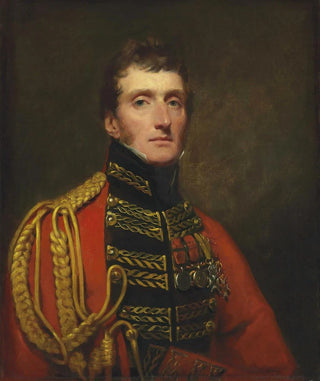Art print | Portrait of Lieutenant General William Stuart - Sir Henry Raeburn


View from behind

Frame (optional)
Portrait of Lieutenant-General William Stuart - Sir Henry Raeburn – Captivating Introduction
The "Portrait of Lieutenant-General William Stuart" painted by Sir Henry Raeburn is an iconic work that embodies the very essence of early 19th-century British portraiture. By capturing not only the physical appearance of his subject but also his character and status, Raeburn succeeds in establishing an emotional connection between the viewer and the depicted figure. This art print, beyond its artistic value, bears witness to a time when identity and prestige were intimately linked to the image one projected. The art print of this masterpiece allows us to appreciate the importance of representation in the society of that era while offering a window into Britain's military and social history.
Style and uniqueness of the work
Raeburn's style is distinguished by his ability to combine realism and idealization. In the portrait of William Stuart, the artist employs a painting technique that highlights the textures of the clothing and the depth of expressions. The play of light and shadow, characteristic of his approach, gives an almost sculptural dimension to the general's face. The meticulous details of the uniform, along with the choice of colors, create an atmosphere of gravity and dignity. Raeburn does not merely depict a man in uniform; he immortalizes a moment in history, a figure embodying authority and command. Stuart's confident posture, coupled with his determined gaze, evokes a quiet strength, a leadership that transcends the simple portrait to become a statement on the military role in society of his time.
The artist and his influence
Sir Henry Raeburn, one of the most renowned portraitists of his era, established himself as a central figure in the Scottish artistic landscape. Trained in oil painting, he developed a unique style that marries the influence of old masters with modern sensibility. Raeburn was the first to explore the potentialities of the portrait as a genre, injecting a psychological dimension into his works. His innovative approach inspired many contemporary artists and paved the way for a new era of artistic representation. By painting emblematic figures like William Stuart, Raeburn

Matte finish

View from behind

Frame (optional)
Portrait of Lieutenant-General William Stuart - Sir Henry Raeburn – Captivating Introduction
The "Portrait of Lieutenant-General William Stuart" painted by Sir Henry Raeburn is an iconic work that embodies the very essence of early 19th-century British portraiture. By capturing not only the physical appearance of his subject but also his character and status, Raeburn succeeds in establishing an emotional connection between the viewer and the depicted figure. This art print, beyond its artistic value, bears witness to a time when identity and prestige were intimately linked to the image one projected. The art print of this masterpiece allows us to appreciate the importance of representation in the society of that era while offering a window into Britain's military and social history.
Style and uniqueness of the work
Raeburn's style is distinguished by his ability to combine realism and idealization. In the portrait of William Stuart, the artist employs a painting technique that highlights the textures of the clothing and the depth of expressions. The play of light and shadow, characteristic of his approach, gives an almost sculptural dimension to the general's face. The meticulous details of the uniform, along with the choice of colors, create an atmosphere of gravity and dignity. Raeburn does not merely depict a man in uniform; he immortalizes a moment in history, a figure embodying authority and command. Stuart's confident posture, coupled with his determined gaze, evokes a quiet strength, a leadership that transcends the simple portrait to become a statement on the military role in society of his time.
The artist and his influence
Sir Henry Raeburn, one of the most renowned portraitists of his era, established himself as a central figure in the Scottish artistic landscape. Trained in oil painting, he developed a unique style that marries the influence of old masters with modern sensibility. Raeburn was the first to explore the potentialities of the portrait as a genre, injecting a psychological dimension into his works. His innovative approach inspired many contemporary artists and paved the way for a new era of artistic representation. By painting emblematic figures like William Stuart, Raeburn






